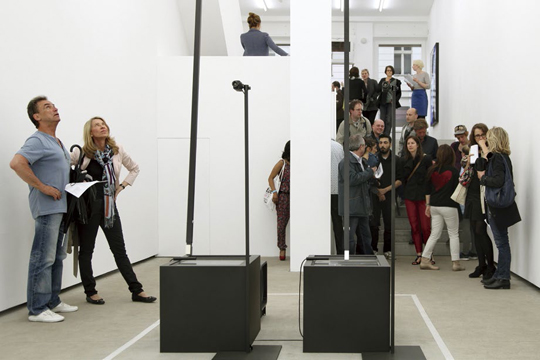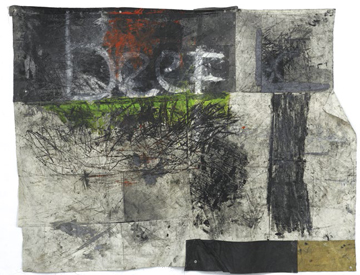BERLIN: BEAUTIFUL FROM AFAR
| July 12, 2013 | Post In LEAP 21

Collectors from all over the world descended upon Berlin in the dwindling days of April for the ninth edition of Gallery Weekend Berlin. While the German capital, a city with less than four million inhabitants, is home to countless galleries—the number varies, depending on whom you ask, though accounts of the current number tend to fluctuate in the mid-hundreds—this year only 51 were on the official roster for the Gallery Weekend extravaganza, which included openings, dinners, performances, and events spread throughout the city. Those seeking some insight into how Prussian-style elitism functions need look no further than the organizational impetus behind such an event. While talk of a “Berlin art mafia” welled up in the German media two years ago when people in the art world began to notice that certain gallerists—among them Esther Schipper, Jochen Meyer of Meyer Riegger, Tim Neuger of neugerriemschneider, and Claes Nordenhake—seemed to be the chief architects not only behind Gallery Weekend, but also Art Berlin Contemporary, the city’s main art fair.
These gallerists’ status only became questionable when accusations of abuses of power were voiced. Three of Berlin’s most prominent galleries—Eigen+Art , Giti Nourbakhsch, and Mehdi Chouakri—were rejected from Art Basel for the first time in 2011, the same year that the six-member Basel selection jury contained three Berlin gallerists: Meyer, Neuger, and Nordenhake. Nourbakhsch publicly voiced her opinion that the act was one of revenge against her for leaving the Gallery Weekend organizing committee the year previous. If so, then it was successful: her gallery, which was long regarded as one of the city’s most important, closed down last year.
While it is a sad reality that life in this major Western art capital is so often tainted by the spießig prejudices and games that belong in the provinces, it is also important for visitors to Gallery Weekend to be made aware that it is only one small part of the Berlin art scene they are seeing: namely, the showrooms of the power-players and those who, either by dint of luck, brazen brown-nosing, or the fact that they are simply too big to be ignored, happen to be in their good graces. As the city is home to very few collectors, the commercial side of the art world here depends on its relations with the outside world, and thus needs the spotlight that events like Gallery Weekend and ABC bring to the city, as well as frequent participation in outside art fairs.
Of those 51 exhibitions lucky enough to be included in April’s showcase of the status quo, two artists in particular stood out, through which we might gather a bit more about Berlin in 2013. The artists, Hans-Peter Feldmann and Oscar Murillo, though aestheti-cally at opposite ends of the spectrum,each had three solo shows— Feldmann at Johnen Galerie, Chouakri (who, along with Eigen+Art , has since been readmitted to the Basel clique), and Wien Lukatsch; Murillo at Isabella Bortolozzi’s main gallery and two temporary spaces.
Both artists cater to a particular market taste: Feldmann, the old-timer Conceptualist, is a proponent of the tendency that sees seriality taken to its most nauseatingly mind-numbing extremes, winning him many sycophants in the institutional side of the German art world (as Thomas Bernhard once noted, Germans tend to mistake morose redundancy for intellectual vigor); while Murillo, the twenty-something Expressionist tastelessly touted by more than one GW-goer as “the new Basquiat”—likely more for his age, ethnic appearance, and dreadlocks than his art— paints paintings that have been sought after by celebrity collectors Don and Mera Rubell.
Overrated? Perhaps that’s being a bit unfair. Feldmann, for his part, at least pulled off a funny prank at his show at Chouakri, with a series of “paintings” consisting of rectangular projections of light against empty walls, each one openly priced at around 25,000 Euros. And, while Murillo may not yet have found a convincing means of merging his performance and video practices with his intriguing, often violent attacks on the canvas, he’s still young enough to come up with an interesting way of doing this—barring that he isn’t prematurely spoiled by the gallery system.

Continuing market anxieties may be behind a reduction of scale that surfaced in several shows, among them two of the strongest seen this year. At Galerie Jochen Hempel, Jong Oh creates barely visible sculptural contraptions with pencil thin lines out of transparent plastic, string, and metal rods; while the obvious influence here is Fred Sandback, Oh nevertheless manages to create a whole lot of something with not very much: one feels the weight of each sculpture upon entering the gallery space, which is very much altered by their presence. Indeed, since the work effectively has to be sought out in the space, the spectator is forced into a cautious stride.
Ugo Rondinone forces weightiness of quite a different sort; he has filled Esther Schipper’s space with dozens of individually bronze-cast horses, each one measuring about ankle-high. It is as though the horses were at graze; a new floor made of bare wood has been installed, and a whole new definition of field is proffered as you make your way through, a giant in this land of exquisitely crafted equus ferus.
Of the few hometown heroes given a chance to shine this year—and one of the few prominent female artists—Isa Genzken’s star was the brightest. Disrupting the monotony of a scene that has a tendency to take itself too seriously, Genzken’s exhibition at neugerriemschneider provided a much needed dose of humor and lightness. Beneath battered umbrellas clearly salvaged (or stolen?) from the outdoor seating of cheap local restaurants and cafes, Genzken arranged her protagonists—an array of dolls and mannequins, all seemingly tormented by their eccentricities, splayed out in anticipation of the summer sun. Of course, it’s a quintessential Berlin motif—the pervasive lack of sunlight, which may explain the sluggish pace of change in this still-emergent art metropolis—and visitors to Gallery Weekend were accordingly welcomed to the city with a steady drizzle of rain. Those as sickened by all the Berlin hype of recent years as its denizens are by the weather might take note, however, that the precarious capital’s vast gallery scene remains an undiscovered country, with venues like Exile, Krobath, Alexander Ochs, and Nagel Draxler—to name but four of the prominent exhibition spaces excluded from this year’s festivities—mining the city’s ever expanding wealth of young talent. But to find them, you’ll need to submit to more than just one sunless weekend here.

